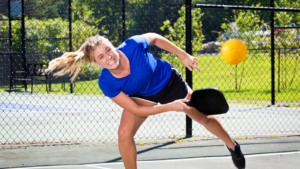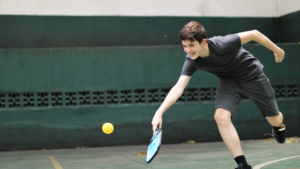Beneath the glaring stadium lights, a moment of hesitation can make all the difference between victory and defeat. In the fiercely competitive world of sports, where split-second decisions can shape destinies, mere actions are not enough. Athletes must hone their abilities to react lightning-fast, seamlessly adjusting to the ever-shifting tides of the game. Welcome to the realm of quick reaction drills, where the focus lies not merely on acting, but on training the mind and body to synchronize flawlessly. This article delves into the realm of reaction, exploring why these drills are indispensable for athletes across disciplines, and how they can elevate performance to extraordinary heights. Get ready to unlock the secrets behind honing the art of reaction, masterfully transforming mere actors into astute reactors on the grandest of stages.
Table of Contents
- Quick Reaction Drills: Train to React, Not Just Act
- Unleashing Your Instincts: The Key to Quick Reactions
- Enhancing Mental Agility: The Science Behind Quick Reaction Training
- Mastering the Art of Decision-Making: Strategies for Lightning-Fast Responses
- Building Reflexes That Save Lives: Practical Tips for Effective Quick Reaction Drills
- Q&A
- In Summary

Quick Reaction Drills: Train to React, Not Just Act
****
When it comes to honing our skills, it’s often easy to focus solely on physical actions and forget about the importance of reaction speed. That’s where Quick Reaction Drills come into play. These dynamic exercises are designed to train our reflexes, enhancing our ability to respond swiftly and decisively in any given situation.
With Quick Reaction Drills, it’s all about challenging both our minds and bodies. Incorporating a mix of cognitive tasks and physical movements, these drills provide a well-rounded training experience. From hand-eye coordination exercises to split-second decision-making challenges, the goal is to enhance not only our speed but also our accuracy and precision.
Here are a few examples of Quick Reaction Drills you can try:
– **Mirror, Mirror**: Stand in front of a mirror and simulate various scenarios. React to specific cues you create for yourself, such as an imaginary opponent throwing a punch or an object being thrown towards you. Observe and adjust your movements accordingly, focusing on swift and precise reactions.
– **Musical Statues**: Play music and move around the room freely. When the music suddenly stops, freeze in place instantly. This drill helps develop quick reaction times as you must remain alert and stop in a split second without any prior indication.
– **Speedy Target Practice**: Set up multiple targets at different heights and distances. With a partner or using a timer, call out which target to hit and aim to strike it as fast as possible. This drill improves both cognitive processing and physical response time.
Remember, becoming a skilled performer is not just about knowing what actions to take, but also about reacting swiftly and effectively. Incorporating Quick Reaction Drills into your training routine can make a significant difference, allowing you to become more responsive and adaptable in any given situation. So, go ahead and train to react, not just act!
Unleashing Your Instincts: The Key to Quick Reactions
Your instincts are a powerful tool, a hidden gem just waiting to be unleashed. They have been honed by millions of years of evolution to help you navigate the complexities of life. Whether you’re facing a split-second decision or engaging in a fast-paced activity, tapping into your instincts can give you an edge and help you react quickly and effectively.
Here are a few ways to tap into your instincts and improve your reaction time:
- Trust your gut: Your gut feeling is often a result of subconscious processing and can guide you in the right direction. Learn to listen to it and trust the signals it sends.
- Train your senses: Your senses are gateways to the external world, and sharpening them can enhance your ability to react swiftly. Engage in activities that challenge your senses, such as puzzles, sensory exercises, or meditation.
- Practice mindfulness: Being present in the moment allows you to fully engage with your surroundings. By focusing on the present, you can react more promptly to unexpected situations.
By embracing and honing your instincts, you unlock a realm of quick reactions and heightened awareness. Empower yourself by trusting your gut, training your senses, and practicing mindfulness. Remember, your instincts are the spark that can ignite your potential and guide you towards success.

Enhancing Mental Agility: The Science Behind Quick Reaction Training
As modern life becomes increasingly fast-paced, the ability to think quickly and react effectively has never been more crucial. Quick reaction training is gaining popularity as a way to improve mental agility, enabling individuals to respond swiftly and accurately in various situations. But what does science have to say about the effectiveness of this training?
Studies have shown that quick reaction training stimulates the brain, improving cognitive functions such as attention, perception, and decision-making. By engaging in exercises that challenge our reaction times, we activate neural pathways responsible for processing information rapidly. This results in heightened mental agility and improved accuracy in making split-second decisions.
To enhance mental agility, a combination of physical and cognitive exercises is often recommended. These exercises may include:
- Reaction games: Playing interactive video games or apps that require quick thinking and response can be an enjoyable way to train your brain.
- Memory exercises: Working on memory-enhancing tasks, such as memorizing a sequence of numbers or recalling details of a given scenario, can help strengthen cognitive abilities.
- Physical activities: Engaging in sports or activities that demand quick reflexes, such as martial arts or dancing, can improve both physical and mental agility.
- Meditation: Practicing mindfulness and meditation can assist in calming the mind, reducing reaction time, and increasing focus.
As with any training regimen, consistency is key. Regularly incorporating quick reaction exercises into your routine can lead to long-term benefits, not only in terms of improved mental agility but also in overall cognitive functioning. So why wait? Start enhancing your mental agility today and reap the rewards in every aspect of your life.
Mastering the Art of Decision-Making: Strategies for Lightning-Fast Responses
When it comes to decision-making, time is of the essence. In today’s fast-paced world, the ability to make lightning-fast responses can make all the difference in seizing opportunities and staying ahead of the competition. But how can you master the art of decision-making and develop the strategies that will allow you to respond quickly and confidently?
To excel in this skill, it is crucial to have a clear understanding of your objectives and priorities. Take the time to identify the critical factors that will influence your decision and list them in order of importance. This will allow you to focus on what truly matters and avoid getting lost in unnecessary details.
Another valuable strategy is to gather as much information as possible before making a decision. This could involve conducting research, seeking expert opinions, or analyzing relevant data. By being well-informed, you will increase your confidence in making swift and accurate decisions.
Additionally, consider the power of intuition. While data and logic play a vital role, sometimes your gut feeling can provide valuable insights that can’t be explained by facts and figures alone. Train your instincts by reflecting on past experiences and learning from both successes and failures.
In the end, mastering the art of decision-making is an ongoing process that requires practice, self-reflection, and a willingness to embrace new perspectives. With the right strategies in place, you can develop the ability to respond with lightning-fast speed, making well-informed decisions that will lead you to success.
Building Reflexes That Save Lives: Practical Tips for Effective Quick Reaction Drills
Quick reaction drills are essential for building reflexes that can potentially save lives. Whether you’re an athlete, a first responder, or someone who simply wants to be prepared for unexpected situations, these practical tips will help you enhance your reaction time and make split-second decisions with confidence.
An important aspect of improving reflexes is regular practice. Consistency is key to building muscle memory and training your brain to respond quickly. Incorporate quick reaction drills into your routine, dedicating specific time each day for this purpose. Visual and auditory stimuli play a crucial role in training your reflexes, so be sure to vary the stimuli you use during your drills.
To make your drills more effective, consider the following tips:
- Challenge yourself: Gradually increase the difficulty level of the drills. Start with simpler tasks and gradually introduce more complex scenarios. Pushing your boundaries will help you develop stronger reflexes.
- Focus on anticipation: Train your mind to anticipate potential scenarios and prepare for them. This mental preparedness coupled with quick physical reactions can make all the difference in critical moments.
- Simulate real-life situations: Incorporate drills that mimic common emergencies or situations you may encounter. By practicing responses to scenarios you may face, you’ll be better prepared to react efficiently and effectively when it truly matters.
- Stay relaxed and maintain composure: Despite the urgency of quick reaction drills, it’s essential to remain calm and composed. Panic can impair decision-making and hinder your reflexes. Practice controlling your emotions during the drills to train yourself for real-life emergency situations where staying calm is crucial.
Remember, building reflexes takes time and commitment. By incorporating these tips into your training routine, you’ll be on your way to developing quick reactions that could potentially save lives.
Q&A
What are quick reaction drills?
Quick reaction drills are training exercises designed to help individuals develop their ability to respond swiftly and effectively to unexpected situations. These drills simulate real-life scenarios and require participants to react promptly, making them valuable in improving decision-making skills and reflexes.
Why is training to react important?
Training to react is crucial because it allows individuals to respond quickly and efficiently in high-pressure situations. It helps them overcome the initial shock or hesitation that often accompanies unexpected events, enabling them to make split-second decisions that could potentially save lives or prevent further damage.
How do quick reaction drills benefit athletes?
Quick reaction drills are particularly beneficial for athletes as they enhance their reflexes, agility, and coordination. By practicing these drills, athletes become more adept at anticipating and swiftly responding to changes in the game, giving them a competitive edge.
Can these drills be useful outside of sports?
Yes, absolutely! Quick reaction drills are not exclusive to sports. They have broader applications in various fields, such as military training, emergency response training, and even everyday life situations. Being able to react quickly and appropriately is beneficial for anyone, regardless of their profession or lifestyle.
What are some examples of quick reaction drills?
Examples of quick reaction drills include reaction ball drills, agility ladder drills, and simulated emergency drills. These drills focus on enhancing coordination, reflexes, and decision-making abilities, allowing individuals to fine-tune their reactions to specific situations.
Are quick reaction drills suitable for everyone?
Quick reaction drills can be adapted to suit individuals of different ages, fitness levels, and skill sets. While some drills may be more advanced, there are always modifications and variations available to accommodate beginners or those with physical limitations, ensuring that everyone can benefit from this type of training.
How often should one practice quick reaction drills?
The frequency of quick reaction drill practice may vary depending on an individual’s goals and schedule. However, it is generally recommended to incorporate these drills into one’s training routine at least two to three times per week to see noticeable improvements in reaction time and decision-making skills.
What precautions should be taken while performing quick reaction drills?
When performing quick reaction drills, it is important to warm up adequately to reduce the risk of injury and to maintain proper form throughout the exercises. Additionally, it may be advisable to start with simpler drills and gradually progress to more complex ones, ensuring a safe and progressive training experience.
In Summary
As we conclude this exploration into the world of quick reaction drills, we continue to marvel at the immense power residing within our minds and bodies. The art of reacting, rather than merely acting, is a skill that unlocks the true potential of any individual, enabling them to tackle life’s challenges with unparalleled finesse.
In this fast-paced, unpredictable world, one thing remains constant: the need for us to adapt swiftly and decisively. It is no longer enough to merely rely on our instincts; we must hone our reactions until they become second nature. Quick reaction drills offer us the invaluable opportunity to cultivate this innate ability, transforming ourselves into agile beings capable of navigating the treacherous waters of existence.
Throughout this journey, we have delved into an array of dynamic exercises designed to sharpen our reflexes, enhance our cognitive abilities, and strengthen our capacity to think and act on our feet. From lightning-fast catch drills that put our hand-eye coordination to the test, to complex maze challenges that push our mental agility to its limit, each drill has served as a stepping stone towards heightened intuition and acute awareness.
Let us not forget that the true significance of these drills goes far beyond the boundaries of mere physical prowess. They train us to remain calm in the face of adversity, to cultivate mental fortitude and unshakeable composure. Through these exercises, we rise above the chaos and embrace a state of mind that allows us to perceive the world around us with heightened clarity and responsiveness.
So, dear readers, as we bid farewell to our exploration of quick reaction drills, let us not merely see it as an end, but as the beginning of a lifelong journey. Let us embrace the art of reacting and carry it with us as we maneuver through the intricacies of existence. May we find solace in knowing that our reactions possess the power to shape our lives, to transform challenges into triumphs, and to define us as individuals.
Now, armed with newfound knowledge and an unwavering commitment to honing our reactions, we venture forth, ready to face the world with astonishing swiftness and unwavering adaptability. Let us never forget that our reactions hold immense power – they have the potential to weave the extraordinary into the fabric of our lives.
Until we meet again, dear readers, may your reactions be swift, your instincts sharp, and your journey one of limitless growth and astounding achievements.
As an affiliate, my content may feature links to products I personally use and recommend. By taking action, like subscribing or making a purchase, you’ll be supporting my work and fueling my taco cravings at the same time. Win-win, right?
Want to read more? Check out our Affiliate Disclosure page.




